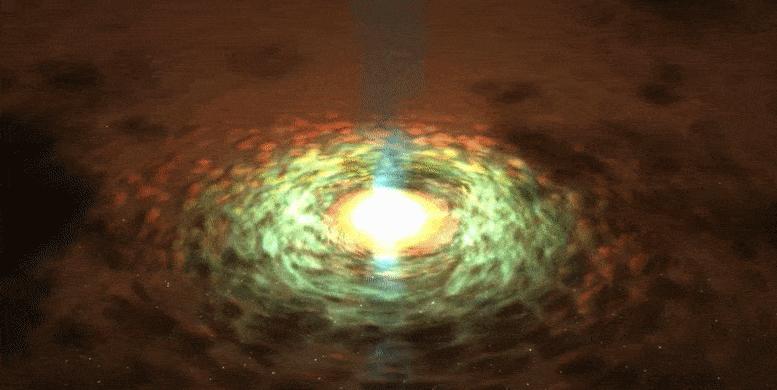◎ Science and Technology Daily reporter Zhang Mengran
According to a study published in the latest issue of the Astrophysical Journal, astrophysicists at the University of Miami, Yale University and the European Space Agency have proposed a subversive textbook view: primordial black holes are the source of all dark matter in the universe.

Artistic representation of the cloudy structure revealed by NASA's Rossi X-ray Timing Explorer satellite data study. Image source: Wolfgang Stephen/UNAM
They built an alternative model of how the universe formed, finding that all black holes (from small needles to black holes capable of covering billions of kilometers) were created immediately after the Big Bang and "occupied" all of the dark matter.
The study suggests that black holes have existed since the birth of the universe, and that these primordial black holes may be the hitherto unexplained ancestors of dark matter. If the newly launched James Webb Space Telescope can collect conclusive data to prove it in the future, the discovery could change the scientific understanding of the origins and properties of the two great mysteries of the universe, dark matter and black holes.
Nico Cappelutti, an assistant professor of physics at the University of Miami, said: "Our research predicted what the early universe would look like if dark matter had not been unknown particles, but came from black holes formed during the Big Bang — as Stephen Hawking thought in the 1970s."
No longer need for "new physics"?
"This will have several important effects," Capelutti said, "and first, we will no longer need 'new physics' to explain dark matter." Second, it will help us answer one of the most compelling questions in modern astrophysics: How could supermassive black holes in the early universe grow so fast? Given the mechanisms we observe today in the modern universe, they didn't have enough time to form. It would also solve the long-standing mystery of why the mass of a galaxy is always proportional to the mass of the supermassive black hole at its center. ”
Dark matter, which has never been directly observed, is thought to be most of the matter in the universe and acts as a scaffold for galaxy formation and development. On the other hand, the black holes that have been observed and can be found in the centers of most galaxies have matter so tightly compressed at a point in their space that they have a strong gravitational pull.
The new study, led by Pulia Wanda Natarajan, a professor of astronomy and physics at Yale University, and Gint Hassinger, director of science at the European Space Agency, shows that primordial black holes of all sizes actually "occupy" all the dark matter in the universe.
How do supermassive black holes form? What is dark matter? In another model of how the universe formed, compared to the "textbooks" of cosmic history, a group of astronomers proposed that both of these cosmic mysteries could be explained by so-called primordial black holes. In the graph, the focus is on comparing when the first black holes and stars appeared, which doesn't mean that black holes aren't taken into account in the Standard Model. Source: European Space Agency
Black holes, you're all a mystery
"Black holes of different sizes remain a mystery," Hassinger explains. "We don't understand how supermassive black holes can become so massive in a relatively short period of time since the universe existed."
Their model tweaked the theory originally proposed by Hawking and physicist Bernard Carr, who argued that within a few fractions of a second of the big bang, tiny fluctuations in the density of the universe might have created an undulating landscape containing "chunky" regions with additional mass. These lumpy regions collapse into black holes.
The theory has no scientific basis, but Capelutti, Natarajan and Hassinger say it could work with a slight modification. Their model suggests that in the early universe, the first stars and galaxies would have formed around black holes. They also propose that primordial black holes have the ability to grow into supermassive black holes by swallowing up nearby gas and stars, or merging with other black holes.
"Primordial black holes, if they do exist, are likely to be the seeds of all supermassive black hole formations, including those at the center of the Milky Way," Natarajan said. "This idea strikes me personally as a very exciting one, and it elegantly unifies two truly challenging problems I'm working on — exploring the nature of dark matter and the formation and growth of black holes— and solving them in one fell swoop."
Confirm or deny, or know the answer quickly
Primordial black holes could also solve another cosmological conundrum: Excess infrared radiation, synchronized with X-ray radiation, is detected from distant, dim sources scattered throughout the universe. The researchers say the growing primordial black holes will exhibit "exactly" the same radiation signatures.
On top of that, the existence of primordial black holes could be confirmed or denied in the near future — depending on the Webb Space Telescope launched from French Guiana late last year and the Laser Interferometer Space Antenna (LISA) mission planned for the European Space Agency in the 2030s.
The Webb telescope, developed by NASA, the European Space Agency and the Canadian Space Agency to succeed the Hubble Space Telescope, harks back more than 13 billion years of cosmic history. If dark matter were made up of primordial black holes, more stars and galaxies would form around them in the early universe, which is exactly what the cosmic time machine could see.
"If the first stars and galaxies had formed in the so-called 'Dark Ages,' Webb should have been able to see evidence of them," Hassinger said.
At the same time, LISA will be able to take gravitational wave signals from the early merger of primordial black holes.
Source: Science and Technology Daily
Editor: Liu Yiyang
Review: Yue Liang
Final Judge: Liu Haiying